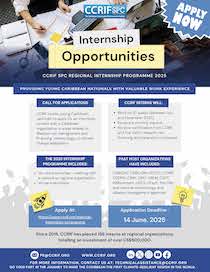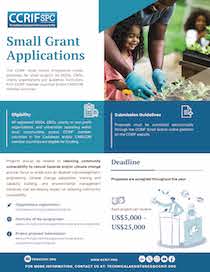Grand Cayman, Cayman Islands, October 6, 2016 – CCRIF SPC (formerly the Caribbean Catastrophe Risk Insurance Facility) is preparing to make a payout to the Government of Haiti as a result of the passage of Hurricane Matthew which triggered a payment on the country’s Tropical Cyclone policy. Based on preliminary calculations, Haiti will receive a little over US$20 million – the largest payment ever made by CCRIF. This was revealed this afternoon by CCRIF Chairman Mr. Milo Pearson at the IMF/World Bank Group Annual Meetings. He also thanked the Caribbean Development Bank (CDB) for paying Haiti’s insurance premiums over the last four years in support of the country’s overall disaster risk management strategy, recognising the key role of risk transfer instruments. Prior to that, in 2010 and 2011, both CDB and the Government of Canada paid Haiti’s annual premium.
Since its inception in 2007, CCRIF has made a total of 15 payouts to 10 member governments totalling US$38.8 million, all within 14 days of the event. This payment will represent the 16th payout, which would make total payouts approximately US$58.8 million.
This payment will be Haiti’s second payment from CCRIF. Recall that in 2010, following the devastating earthquake, CCRIF made a payment to the Government of Haiti of US$7.7 million, based on the terms of its Earthquake Policy. That payment represented the first inflow of direct financial assistance received by Haiti at that time. The Haitian government used the CCRIF funds to cover salaries of key emergency personnel, thereby “keeping the wheels of government turning.”
CCRIF’s parametric insurance products are insurance contracts that make payments based on the intensity of an event (for example, hurricane wind speed, earthquake intensity or volume of rainfall) and the amount of loss calculated in a pre-agreed model caused by these events. Parametric insurance enables payouts to be made very quickly after a hazard event. This is different from traditional insurance settlements that require an on-the-ground assessment of individual losses after an event before a payment can be made.
Hurricane Matthew made landfall in Haiti on October 4 as a powerful Category 4 Hurricane. A United Nations representative to Haiti, Mourad Wahba, said the country was facing its largest humanitarian crisis since the earthquake in 2010 left more than 200,000 dead and tens of thousands living in tents and makeshift dwellings. Over twenty-three deaths have been reported so far and Matthew has caused significant damage to the southern coast. According to HRA (the Haiti Renewal Alliance), Matthew brought intense rain, wind and surge waves, causing mudslides and flooding. The main bridge that links the capital of Port-au-Prince to southern Haiti has collapsed and the coast has been badly hit in the areas of Grande Anse, Port-Salut and Port-à-Piment with 1,243,000 people (including 522,000 children) affected. Les Cayes has been totally flooded. Initial estimates suggest that 4 million children in Haiti will be directly affected by the storm.
CCRIF CEO, Mr. Isaac Anthony stated, “The CCRIF Board and Team extend our condolences to Haiti on the loss of life and extend our support to the Government and people of Haiti as they recover from this disaster.” Having already spoken to the Government of Haiti this morning, Mr. Anthony further stated that “we know that the Government welcomes this payment and is looking forward to beginning their recovery efforts”.
Earlier, as Matthew moved through the eastern Caribbean islands, the centre of the storm passed over Barbados on September 28 as a Tropical Storm, triggering its CCRIF Tropical Cyclone policy. Barbados will receive a payout of US$975,000. According to Barbados’ Department of Emergency Management, all businesses closed that day until the all clear declaration on the morning of 29 September. There were reports of fallen trees, isolated flooding, power outages and water disruption in some parts of the island.
Both Barbados and Haiti have Excess Rainfall policies also. Tropical Cyclone policies are designed to cover damages from wind and storm surge but not rainfall. Therefore, it is possible that these countries’ rainfall policies may be triggered as well – this would entitle them to an additional payout. There also is a possibility that other countries in the Eastern Caribbean who were earlier affected by Matthew may receive payouts under their Excess Rainfall policies. The model for excess rainfall events requires a few days longer to calculate results compared with the wind-based tropical cyclone model and CCRIF will issue new information when that assessment is complete.
CCRIF and the work we do continue to be cited as an internationally recognized example of a risk transfer mechanism that should be seen as a key and indispensable component of countries’ strategies for economic development, disaster risk management and climate resilience as these countries seek to achieve higher levels of growth, reduce poverty and become internationally competitive.
About CCRIF SPC: CCRIF SPC is a segregated portfolio company, owned, operated and registered in the Caribbean. It limits the financial impact of catastrophic hurricanes, earthquakes and excess rainfall events to Caribbean and – since 2015 – Central American governments by quickly providing short-term liquidity when a parametric insurance policy is triggered. It is the world’s first regional fund utilising parametric insurance, giving member governments the unique opportunity to purchase earthquake, hurricane and excess rainfall catastrophe coverage with lowest-possible pricing. CCRIF was developed under the technical leadership of the World Bank and with a grant from the Government of Japan. It was capitalized through contributions to a Multi-Donor Trust Fund (MDTF) by the Government of Canada, the European Union, the World Bank, the governments of the UK and France, the Caribbean Development Bank and the governments of Ireland and Bermuda, as well as through membership fees paid by participating governments. The Central America SP is capitalized by contributions to a special MDTF by the World Bank, European Commission and the governments of Canada and the United States.
English





